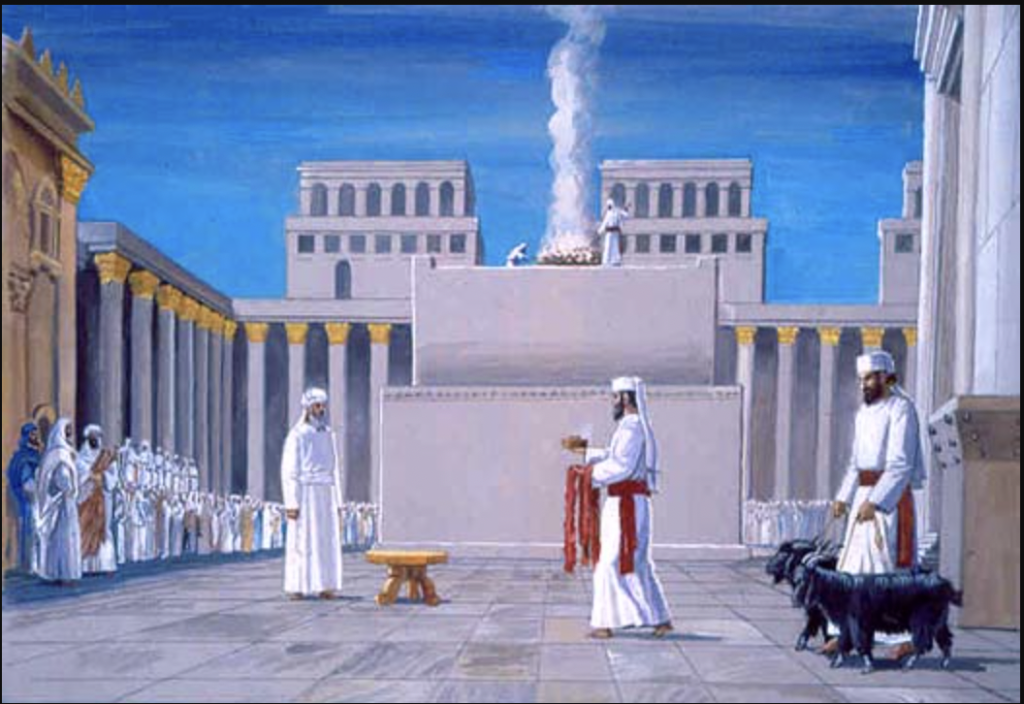
Lent & the Word of Wisdom
Written by Alisa McHarness
The Work of the People
It is natural for people to form traditions that shape how they and their communities experience life and important events together. Traditions are anchor points that give a sense of stability when circumstances are difficult and they are also delightful breaks from routine that remind us that something is important and special. After the original Apostles passed away the communities they started began to create traditions that would anchor and shape how they remembered the important and special things about their faith. These traditions grew and took shape over time and were called “Liturgy”, which means “the work of the people”. As a convert to the church, after spending a decade in the Episcopal church, this series is my exploration of how the liturgy of the traditional Christian church can inform and enrich our experience as Latter-Day Saints striving to live out the message of the original Apostles.
A Word of Wisdom, for the benefit of the council of high priests, assembled in Kirtland, and the church, and also the saints in Zion—To be sent greeting; not by commandment or constraint, but by revelation and the word of wisdom, showing forth the order and will of God in the temporal salvation of all saints in the last days—Given for a principle with promise, adapted to the capacity of the weak and the weakest of all saints, who are or can be called saints.
D&C 89:1-3 Tweet
Doctrine and Covenants 89 was given in revelation to Joseph Smith on February 27, 1883 and has become a recognizable (if often misunderstood) feature of Latter Day Saint practice that sets us apart from the Protestant churches around us. Yet divinely inspired instruction around food and how church leadership has had need to interpret, instruct, and enforce those commands is not new and is consistent with the entire arc of the scriptures from Genesis to Moroni. There were the dietary laws of the books of Moses, interpreted and clarified over the centuries to become the kosher laws (kashrut) our Jewish brothers follow to this day. In the Americas “the people did observe to keep the commandments of the Lord; and they were strict in observing the ordinances of God, according to the law of Moses. . .” (Alma 30:3). In the days of the Apostles they continued to observe kashrut, the feasts and fasts, and maintained the ritual purity required to be able to meet at the Temple in Jerusalem. Later the Apostles themselves would include instruction regarding food in their epistles and they, or their disciples, would author the Didache (ca. 50-120 ce) a manual for new members of the church that included instruction about food and fasting [1]. As time progressed the Catholic and Orthodox
churches would have specific instructions around food, not as part of a daily practice, but as it related to fasting, both personal and communal. The later Protestant movement would abandon much of those remaining teachings regarding food and it isn’t until the revelation of the Word of Wisdom that there is any degree of returning to instruction around food as part of a daily spiritual practice. For some members, and certainly for some converts, the instruction and restrictions around food often doesn’t make sense and attempts to justify it as a health code can fall flat. In this the influence of Protestant thought on our wider western and church culture is pervasive and can be difficult to distinguish. When we look back at the roots of Christianity in the first couple centuries, and at the Jewish faith that birthed it, we can gain a new perspective and clarity on the teachings of a church that is not a branch off the reformation but is a restoration of the church as it was immediately following Christ. So what is the role of dietary rules, what we eat or don’t eat, in the life of one who covenants themselves to the God of
Israel? Is it about more than just being “healthy” and can the principle of abstaining from foods as part of a regular spiritual practice bring greater clarity and depth to our relationship with the Word of Wisdom?

The dietary laws of Leviticus 11 and Deuteronomy 14 are extensive and may seem overly
restrictive to the sensibilities of anyone born outside of the Jewish community; and the
additional rules and restrictions that were added over the centuries by Rabbinic Judaism can likewise seem unnecessarily complicated. Many of the expansions on kashrut were applied to clarify questions of how to follow the laws in a practical sense. For example, three times there is a prohibition given forbidding eating the flesh of a kid with its mothers milk – but how does the law apply if it is the milk of an animal that is not the mother, or does the law mean not to cook a kid in milk in general? What if you eat meat and milk separately but since they end up in the same place, the stomach, and mix there – does the law apply to that? And does the law apply to just goats or was it meant to be understood as applying to all meat? Modern kashrut were developed and have changed over time to answer questions like these about how to interpret and practice kosher laws [2], and we see something similar happening after the revelation of the Word of Wisdom. Initially the Word of Wisdom (WoW) was given, not as a commandment, but
as a type of “best practice”. “Church members—including leaders—differently understood, inconsistently applied, and even neglected its directives. In accordance with a provision in the revelation, church members continued to use wine for the sacrament of the Lord’s Supper. Although observance of the Word of Wisdom was not generally viewed as a standard of worthiness, nonobservance sometimes resulted in church discipline” [3]. However, it was understood that it would eventually become a requirement for all members of the church, which it did during the presidency of Heber J. Grant in 1921 [4]. But as the text of the WoW itself makes no distinction between the different commands and the language was rather vague there was a need for interpretation and instruction required to establish what the WoW meant, especially as regards specific circumstances, and what aspects of the WoW would be
mandatory and what would merely be recommendations. Interpretation of the WoW has evolved over the years to include some substances never mentioned in the WoW, such as recreational drugs, while other substances, such as hot soup or chocolate, were debated but then considered to be acceptable [5]. The other commands in the WoW regarding food have been interpreted to be recommendations and are not required. To the extent that references to the WoW in church literature almost exclusively refer not to the entirety of the text but to only the first 9 verses.

As a convert I can attest that the implementation and restrictions of the WoW can seem
arbitrary. Having your “worthiness” as a member measured in part by what socially acceptable foods you abstain from consuming while other aspects of the commandment are generally ignored can be a difficult standard to submit to and may seem to be even more confusing for some in light of the general lack of restrictions taught by the Apostles in the first century. The text of Acts attests that the Jewish Apostles, including Paul, continued to follow kashrut as men born into the Abrahamic covenant, but as the church expanded, and God made clear that the gospel was for all nations, a debate arose as to whether gentiles needed to abide by the laws of the Mosaic covenant as well [6]. Ultimately the council at Jerusalem would determine that Gentiles did not need to become subject to the laws of the Mosaic Covenant “save only that they keep themselves from things offered to idols, and from blood, and from strangled, and from
fornication” (Acts 21:25). Within a century the instructions regarding food to the primarily Gentile church simply stated they should refrain from food offered to idols, and to observe a fast on the fourth and sixth days of the week [7]. As the church expanded and became the official religion of Rome food offered to idols became a moot point so only instruction regarding fasting regularly remained. To this day the Orthodox Church and some of the Catholic church continue to observe corporate fasts on the fourth and sixth days of the week (Wednesday and Friday) in remembrance of Christ’s betrayal and crucifixion [8][9]. Additional fasts came to be observed as part of the spiritual preparation for important feasts, such as Easter and Christmas. Lent is the
40 day fast that has come to be observed in the weeks leading up to Easter, it actually
comprises 46 days since Sunday, the Lords Day, is always a remembrance of Christ’s
resurrection and therefore always a “feast” day. Lent as it is known today was made a
mandatory fast by the Council of Nicea in 325 ce – it was part of the movement to standardize and centralize Christian doctrine and worship; prior to the council there had been a variety of traditions practiced that had developed independently in the various communities established by the Apostles. The Egyptian church had a well-established practice of a 40 day fast as part of preparation for baptism, taking as its model Christ’s 40 day fast and an ancient tradition for the date when Christ baptized his disciples. This Egyptian tradition occurred after Epiphany (January 6) and before Holy Week. Other Churches also observed some kind of fast as preparation for baptism – those fasts ranged in duration depending on the community, from 40 hours up to three weeks in the case of the Roman Church. Over time Easter itself became an increasingly popular date for baptisms and the baptismal preparatory fast became established in 325 ce. as a universal practice of repentance and reflection for all Christians, not just the ones
to be baptized on Easter [9][10][11].

The purpose of fasting as part of a repentance process has its roots in the Jewish fast and feast cycle. At the time of Christ there was a well-established practice of personal fasting for a variety of reasons and several corporate fasts [12] that were in addition to the fast that is commanded by God on the Day of Atonement (Yom Kippur). Yom Kippur is referenced in Acts 27:9 and is simply referred to as “The Fast”. The purpose of fasting on Yom Kippur was to “afflict the soul” (better translated as “afflict the flesh”) with the goal of increasing the desire for God and righteousness through the temporary denial of physical desires. The practice of “afflicting the flesh” through fasting was an alternative to the physical mutilation practiced by the other cultures around Israel, just as animal sacrifice was an alternative to human sacrifice as a means of gaining favor with a deity [13].
Yom Kippur is the most holy day in the entire Jewish calendar and temple services for that day revolved around the ritual cleansing of the temple, the dedication of the scape goat, and the one time of the year that the High Priest would enter the Holy of Holies and symbolically reunite all of Israel with God [14]. As believers in Jesus Christ the connection between the ritual atonement of Israel on Yom Kippur and the work of Christ in Gethsemane and Golgotha is clear and was certainly understood by the Apostles and the early church. Making fasting a natural part of the preparation process for the baptism that unites believers with the death and resurrection of Christ on Easter. Thus Lent is the result of 300 years of Christian practice being homogenized into a single tradition, as part of an unbroken chain of tradition where fasting was observed as part of a repentance and preparation process. From the Jewish fasts observed by the Apostles,
through the various traditions of the early church, and up to today.

Additional insight into the spiritual purpose of fasting can be gained from Jewish kabbalistic thought where rather than bringing about separation from the flesh in pursuit of “greater” spiritual things – fasting in fact unites us more fully with our bodies as our sustenance comes from what is within us rather than without. This is seen as a type of the world to come where the “physical dimension of existence is not abolished, but is preserved and elevated” to its final perfected state where ““the soul will be nourished by the body” itself, and the symbiosis of matter and spirit that is man will not require any outside sources of nutrition to sustain it.” [15] This view of perfected physical bodies is much more in line with LDS doctrine than Protestant or Reformed theology that tends to emphasize the total abandonment of all things physical after this life. So in this we see that fasting spiritually brings us closer to God both through repentance for our human frailties and through the remembrance that our physical bodies are divine in origin and essential elements of our eternal progression.
The principle of fasting is only one aspect of understanding our relationship to food and other physical desires as part of a spiritual discipline. While Yom Kippur and Lent are once a year occurrences, seeking to unite ourselves to the will of God in both body and spirit should be a daily practice. This is where we return to the question of kashrut and the WoW. In Christian thought it is not unusual for explanations or rationalizations of kashrut to center around the safety of certain foods in the ancient middle east or around purported health benefits of eating kosher. These arguments are then sometimes given as part of the reason why God “abolished” kashrut in the New Testament era. This is similar to some of the rationalizations that are commonly given for the WoW being about physical health and that not all the commands need be strictly followed due to aspects like improved food storage [16]. And while there is certainly plenty of evidence for the physical benefit of either diet there is a spiritual benefit that is far more significant. Within Judaism the primary reasoning given for following kashrut is simply because God said to. There is no further explanation or rationalization needed because the aim of a covenant people is to draw close to God by obeying His will [17] much the same way a child seeks to draw near to and emulate its parent by copying what they say and do. There are moral, physical, and social benefits to kashrut given by Jewish sages, but they are considered to be secondary benefits. Ultimately any argument for the health benefit of any diet can be studied, debated, proven, or debunked. Focusing firstly or at length on the physical benefits of the WoW de-emphasizes its spiritual power. The principle of opposition in all things applies to what and how we consume food as much as to anything else in our mortal experience and is illustrated in the following explanation for the purpose of kashrut – “The Creator desired a world where we creatures would have a choice to connect with Him or go on our own messy way. He conceived
of us as creatures who consume food, and that would be one of the areas where we would have this choice. If so, just like there have to be foods that we can eat as part of that connection, so too there have to be foods whose eating will disturb that connection. . . Whenever we eat something mindful of our Creator and divine purpose, our act of eating acts as a connection to Above. The energy we receive from that food itself becomes elevated into that higher purpose… On the other hand, if we just eat that food because we are hungry, with no inner intent, we and the food remain just another chunk of this fragmented world.” [18] In his April 2010 conference talk President Uchtdorf shared a story of how he learned that the benefit of the WoW was first a spiritual one and that any temporal benefits followed after, “years later I could see clear evidence of the temporal blessings that come to those who obey the Word of Wisdom—in
addition to the spiritual blessings that come immediately from obedience to any of God’s laws”
(emphasis added) [19].

The promised blessings given at the end of D&C 89 makes no distinction between the various commands and the benefits of obedience. Our prophets have consistently interpreted over time which of the commands we are to be held accountable to as a covenant people, but the remainder of the WoW exists as an invitation to go beyond the minimum requirements. “Elder Ezra T. Benson, a member of the Quorum of the Twelve under President Brigham Young, broadened the usual interpretation of the Word of Wisdom when he said: “When we first heard the revelation upon the Word of Wisdom many of us thought it consisted merely in our drinking tea and coffee, but it is not only using tea and coffee and our tobacco and whisky, but it is every other evil which is calculated to contaminate this people. The Word of Wisdom implies to cease
from adultery, to cease from all manner of excesses, and from all kinds of wickedness and abomination that are common amongst this generation—it is, strictly speaking, keeping the commandments of God, and living by every word that proceedeth from His mouth” [20]. Periods of fasting gives us the opportunity for self-examination and assessment of how well we are keeping the commandments of God. For those who observe Lent there are 4 disciplines that are generally observed: abstinence of either a food item or other temporal pleasure, increased prayer, charity, and reflection. Lent then is a gift left to us by our spiritual ancestors and is an invitation to “plant the word (of wisdom) in your hearts, that ye may try the experiment of its goodness.” (Alma 34:4) This year (2024) Lent begins on February 14; I invite you to consider this Valentines Day an opportunity to turn towards the Savior with love and “afflict your flesh”
with choosing to observe some aspect of the WoW in a way that you have not before. Give up the taste of Coke or chocolate or other temporal pleasure and instead “taste and see that the LORD is good.” (Ps 34:8)
Resources

Love What You're Reading?
Don’t forget to check out our weekly podcasts!

Shatter Your Triangles
Sometimes we think we have an understanding of the Gospel, but when we take another look at what the scriptures, our paradigms can completely shift! Our Shattering Triangles team aims to help you deepen your testimony and doctrinal understanding to some of the more prominent questions found among members.

Up Your Preparedness Game
Our Honey + Lilies Blog is dedicated to helping you prepare for the days ahead. Want to get started? Click here.

I really enjoyed reading this. Sometimes it can be challenging to connect Lent with our beliefs and it was eloquently written and easy to understand, especially since I don’t have as much knowledge of other religions and early church history in Christ’s time.
This was a well written article with great insights about the WoW, Lent, and our connection with the Lord. I appreciated all the research and especially loved the quote, “Whenever we eat something mindful of our Creator and divine purpose, our act of eating acts as a connection to Above.”
Really great breakdown. This article provides valuable insight into the word of wisdom in both a historical context, and in comparison to the of similar tradition of Lent (practiced by many modern-day Christian’s) and the Jewish faith.
Great article. I enjoyed your insight on various relationships between Lent and the Church of Jesus Christ’s revealed word of wisdom. The literal, physical benefits and representation, and the spiritual deeper meaning. I look forward to reading future articles from your research and perspective.
Very thorough and insightful. Thank you for this fine piece of work.